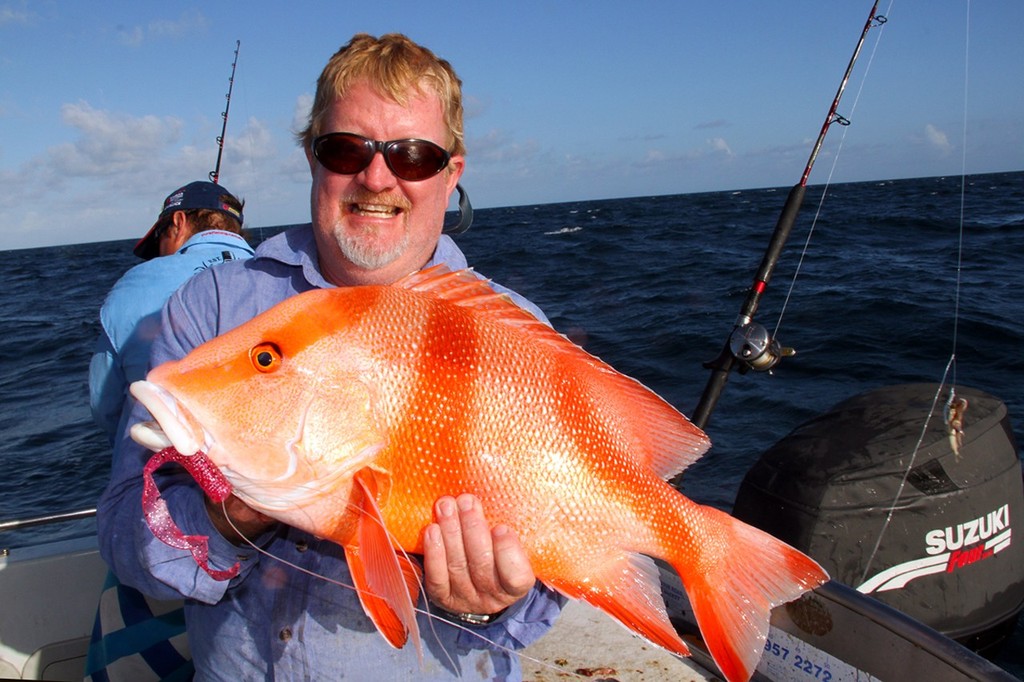Deepwater jigs II - Wagging the curly tail
by Lee Brake on 11 Mar 2013

A perfect example of a curl tail on a paternoster rig. Graham Brake used a Zman to nail this nice red. Lee Brake
Last week we looked at the speedsters of the soft plastic jigging stable, the jerkshads. This week Lee Brake is slowing things down a bit and focusing on those wagging, flowing, twirling curl tails.
Curl tails are amongst the oldest soft plastic style. Traditionally they were known as grubs or even ribbontails and were more the lure used for slow casting and retrieving, however, they are also very effective in the deep, if worked correctly.
As a rule, this means working them the complete opposite to jerkshads. You'll remember that jerkshads work best if jerked aggressively to make them dart side-to-side. Well, curl tails rely on their curly tail to imitate a fish, not their body, so there's no need to jerk the body around like it's a dodgem car driven by a 10 year old. Instead, most of the action is in the rise and fall of the plastic.
The tail will flutter and wag along behind the plastic and is usually as long as the body, sometimes longer, so it's not a subtle action. Usually just drop the plastic to the bottom, pause, then slowly lift and wind your combo like you would if you were pulling in a mud crab that you didn't want to let go of a bait. Where the fish are sitting (on the bottom, on a pinnacle or mid-water) will dictate how high you work the softy, but once at the desired height, free-spool once more. It's pretty simple, and that's why this plastic is a great choice for beginners. In fact, I've seen curl tails rigged off paternoster rigs and just fished like bait as we've drifted along. They've gotten just as much attention as the baits!
The simplicity of these plastics can be the undoing of many anglers. They feel that they need to twitch, crank and rip them and, in doing so, they invariably foul the tail on the hook. Once fouled, you're left winding in a useless lure and in deep water this is about as frustrating as my missus playing Adele on repeat.
Now, not all curl tails are super prone to fouling up. Usually the softer the plastic and the longer the tail, the easier it is for the tail to find, and hold, the hook point. Some plastics like the Gulp Nemesis, which have the body of a jerkshad but with a curl tail, can be twitched quite vigorously. Whereas others, like the Zman GrubZ, don't like much twitching at all. But that doesn't mean one is better than the other. It's just a compromise.
Personally, if I'm fishing reef edges and trying to tempt a finicky sweetlip, parrotfish or coral trout, I'll probably go for a 5' super soft, long tailed grub; whereas in the deeper water where I may have to work the lure through the whole water column to imitate baitfish, I'll go for a firmer, shorter curl tail (or a jerkshad).
Rigging is also important and relates directly to hook-up rate.
The hook will usually run the length of the body, but should never impede the tail. I like a narrow gape hook rather than a wide gape, as it will have less chance of snagging the tail. Also, I like a light jighead rather than a heavy one. This is a plastic meant to futter, not tear through the depths like a torpedo, so it doesn't matter if it takes a while to get into the strike zone, as long as you can still feel the lure and remain in control.
As I mentioned, you can also run this plastic on a paternoster rig. I like to run a 7/0 long shank hook on the top dropper loop with a curl tail on it and then a bait on the loop underneath. I believe this adds an extra element of attraction to the rig and brings fish in for a look from a long distance, even if they do end up taking the bait!
The other key is to fish these with some finesse. Unlike jerkshads where you can expect a freight train hit, curl tails are often 'mouthed' like baits and premature striking can both miss you the fish and lose you a tail. Instead, drop the rod tip when you feel any weight, and then set the hook only when your rod loads up. A slightly longer, fast tapered graphite rod is very effective (6'-6'6').
If you are repeatedly missing fish, try trimming some of the body off the front of the plastic so that it can take a smaller hook size. This will often lead to fish engulfing the whole lure rather than biting the tail.
All in all, curl tail softies are action-packed, easy to use lures that attract a variety of fish. They are probably my favourite lure for targeting tasty reef fish that school up in lagoons and bays at night. Sweetlip, red throat and spangled emperor particularly love them. They are also dynamite over deep shoals for grunter (javelin fish) and fingermark, as you can see in the video below where we use them to jig up a pair of cracking fingermark.
If you want to link to this article then please use this URL: www.sail-world.com/107390